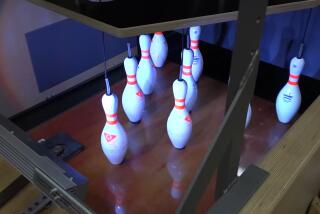In-Line Skating Glides From Fad to Mainstream
- Share via
ATLANTA — Some thought it would be just a passing fad, but in-line skating has survived its early growth spurt to become a mainstream American form of leisure. And in-line skate and equipment sales have continued to soar when some thought they would start to fall.
Companies selling skates and accessories at the recent 1995 Sporting Goods Manufacturers Assn. Super Show here gave optimistic assessments of the sport’s future.
In one of the biggest signs of the industry’s growing appeal, sneaker giant Nike Inc. of Portland, Ore. will soon complete the purchase of Canstar Sports Inc., the world’s largest hockey equipment manufacturing company, for $395 million.
Through Nike’s considerable worldwide marketing and sales know-how, Canstar ice hockey and in-line skating products (Bauer and Cooper brands) will surely experience a significant boost--as will the rest of the industry--in years to come.
“This is the biggest news this year in sporting goods,” said Andy Mooney, vice president of new business development at Nike. “If you take this show as a microcosm of the industry, in-line skating and hockey are the two big pockets of excitement.”
Nike, already a household name in sports footwear and clothing, is setting its sights on Eastern Europe, which it feels is ripe for in-line skating.
From an unassuming start in the early 1980s as an off-season training device for ice hockey players, in-line skating, developed by Rollerblade Inc., has grown rapidly into a sport with appeal for all ages.
Rollerblade estimates that about 16 million Americans in-line skated last year. According to SGMA data, 12.6 million did it in 1993 and 9.4 million did it in 1992.
In wholesale dollar sales, SGMA said that in 1994 about $495 million was spent last year, up from $290 million in 1992.
Rollerblade, a privately held company that claims a 50% U.S. market share, doubled its sales in 1994.
Several key factors have contributed to the dramatic rise of in-line skating. Easy-to-use braking systems that allow even a timid beginner to feel confidence in controlling speed are foremost among the factors.
In addition, greater promotion by manufacturers of safety, such as Rollerblade’s Asphalt Bites campaign, have resulted in fewer injuries and an increase in use by skaters over age 35.
The industry’s flexible image appeals to recreational, stunt and fitness skaters, as well as to roller hockey players, the fastest growing group. Furthermore, the industry manufactures equipment geared to each of these segments as well as organizes leagues to promote competitions.
Finally, the increasing popularity in hockey, both ice and street hockey, has helped in-line skating.
Street hockey players with newly acquired in-line skating skills, in-line skaters eager to play a team sport, and ice hockey lovers, unable to find or afford ice rink play, joined together to create the surge.
More to Read
Inside the business of entertainment
The Wide Shot brings you news, analysis and insights on everything from streaming wars to production — and what it all means for the future.
You may occasionally receive promotional content from the Los Angeles Times.










